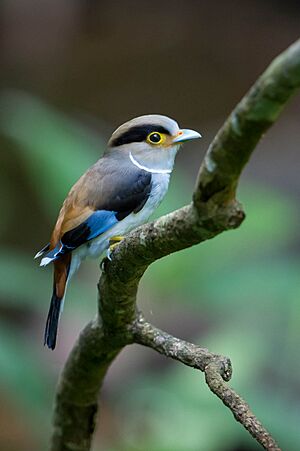Silver-breasted broadbill facts for kids
Quick facts for kids Silver-breasted broadbill |
|
|---|---|
 |
|
| Male in Vietnam | |
 |
|
| Female in Thailand | |
| Conservation status | |
| Scientific classification | |
| Genus: |
Serilophus
|
| Species: |
lunatus
|
The silver-breasted broadbill (Serilophus lunatus) is a colorful bird found in parts of Southeast Asia. It belongs to a bird family called Eurylaimidae, known for their wide, flat beaks.
There are seven different types, or subspecies, of the silver-breasted broadbill. Another bird, the grey-lored broadbill, used to be thought of as a type of silver-breasted broadbill, but now it's considered a separate species.
Contents
About Its Name
The silver-breasted broadbill was first officially described in 1834 by an English bird expert named John Gould. He gave it the scientific name Eurylaimus lunatus.
The second part of its name, lunatus, is a Latin word. It means "crescent-shaped" or "sickle-shaped," like the moon. This name likely refers to a feature on the bird.
The first place this bird was found and described was near Rangoon (now Yangon) in Myanmar. Later, this location was narrowed down to the hills near Bago.
Today, the silver-breasted broadbill is one of two species in a group called Serilophus. This group was created in 1837 by William Swainson.
Different Types of Silver-breasted Broadbills
There are seven recognized subspecies of the silver-breasted broadbill:
- S. l. elisabethae: Found from central Myanmar to northeast Thailand, northern and central Laos, northern Vietnam, and southern China. It's also in southeast Thailand and Cambodia.
- S. l. polionotus: Lives on Hainan Island, which is off the coast of southeast China.
- S. l. lunatus: This is the main type, found in southern Myanmar and northwest Thailand.
- S. l. impavidus: Found in southern Laos.
- S. l. stolidus: Lives in southwest Thailand and most of the Malay Peninsula.
- S. l. rothschildi: Found in the mountains of the southern Malay Peninsula.
- S. l. intensus: Lives in the mountains of Sumatra.
What It Looks Like
The silver-breasted broadbill is a medium-sized bird. It is about 16–17 centimetres (6.3–6.7 in) long and weighs between 25–35 grams (0.9–1.2 oz).
The main type of this bird has rusty-colored feathers on its head. Its forehead is ash-grey, and it has a wide black stripe above its eye. Its chest and belly are white. The feathers on its lower back and upper wings are bright reddish-brown.
Its flight feathers, which are used for flying, are a striking blue and black. Its tail is black.
Male and female silver-breasted broadbills look a little different. This is called sexual dimorphism. The female has a thin silver band across her chest that the male does not have. Young birds look similar to adults but have shorter wings and tails, and their feathers are a bit darker. The different subspecies can also look slightly different from each other.
Where It Lives and Its Home
The silver-breasted broadbill can be found in many countries. These include Cambodia, China, Indonesia, Laos, Malaysia, Myanmar, Nepal, Thailand, and Vietnam.
It lives in different kinds of forests. These include warm, wet lowland forests and moist mountain forests. Sadly, the number of these birds has gone down a bit because their homes are being destroyed. However, they are not currently in danger of disappearing completely.
This bird lives in various forest environments. It can be found in tropical and semi-tropical forests. It also lives in forests where trees lose their leaves part of the year, or in forests with lots of pine, oak, and bamboo trees. Sometimes, it can even be seen in forests where some trees have been cut down, or even in farms and gardens.
The broadbill lives at different heights above sea level depending on the area. In Sumatra, it lives between 800–2,000 metres (2,600–6,600 ft) high. But in China, it lives at lower heights, between 300–700 m (980–2,300 ft).
How It Behaves
Food and Feeding
The silver-breasted broadbill mainly eats small creatures without backbones, called invertebrates. Most of its diet consists of insects. It enjoys eating grasshoppers, mantises, caterpillars, and insect larvae. It also eats small land snails.
These birds catch insects in two main ways. They might fly out from a branch to catch an insect in the air. This is called flycatching. Or, they might pick insects directly off leaves and branches. This is called gleaning.


